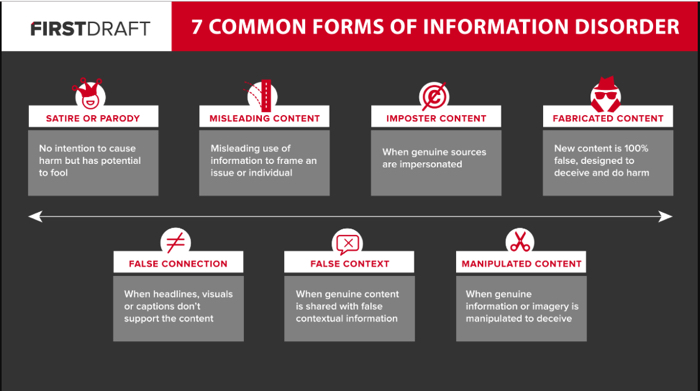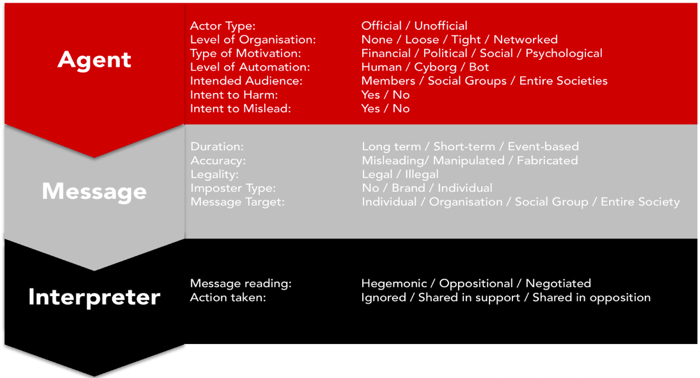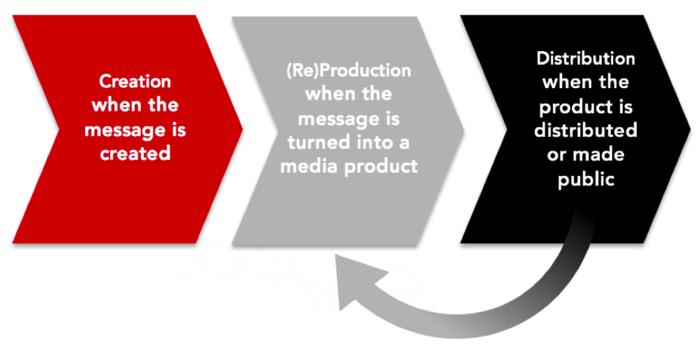
With the spread of fake news, journalists need to recognise and understand the different categories, types, elements, and phases of information disorder.
Claire Wardle sets out the seven common forms of information disorder.
Categories of information disorder
- Satire or parody: No intention to cause harm but has potential to fool.
- Misleading content: Misleading use of information to frame an issue or individual.
- Imposter content: when genuine sources are impersonated.
- Fabricated content: New content is 100% false, designed to deceive and do harm.
- False connection: When headlines, visuals, or captions don’t support the content.
- False context: When genuine content is shared with false contextual information.
- Manipulated content: When genuine information or imagery is manipulated to deceive.

Types of information disorder
- Misinformation: Unintentional mistakes such as inaccurate photo captions, dates, statistics, translations, or when satire is taken seriously.
- Disinformation: Fabricated or deliberately manipulated audio.visual content. Intentionally created conspiracy theories or rumours.
- Malinformation: Deliberate publication of private information for personal or corporate rather than public interest. Deliberate change of context, date or time of genuine content.

Elements of information disorder
- Agent
- Message
- Interpeter

Phases of information disorder
- Creation: When the message is created.
- (Re) Production: When the message is turned into a media product.
- Distribution: When the product is distributed or made public.

Note: This material above first appeared on First Draft and has been reproduced here with the author’s consent.

Expanding the context; The erosion of trust
The prevalence of fake news isn’t merely a nuisance; it’s a symptom of a broader societal shift. We’re living in an information ecosystem where trust is increasingly fragile. The internet, while democratising access to information, has also lowered the barriers to its manipulation. This creates a fertile ground for information disorder to flourish.
Categories of information disorder: Beyond simple definitions
- Satire or parody: While often harmless in intent, the line between satire and misleading content can blur, especially when taken out of context or shared with audiences unfamiliar with the original source. The danger lies in the potential for misinterpretation and the subsequent spread of misinformation.
- Misleading content: This category highlights the power of framing. By selectively presenting information, even if factually accurate, manipulators can create a distorted narrative. Understanding how framing works—through choice of language, imagery, and emphasis—is crucial for journalists.
- Imposter content: This form preys on established trust. It underscores the importance of verifying sources and understanding how easily digital identities can be faked.
- Fabricated content: This is the most insidious form, as it involves the deliberate creation of falsehoods. Recognising the telltale signs of fabricated content, such as lack of sourcing, emotional manipulation, and inconsistencies, is essential.
- False connection, false context, and manipulated content: These categories emphasise the importance of context. Even genuine content can be weaponised when its context is altered. Journalists must be meticulous in tracing the origins of information and ensuring its accurate presentation.
Types of information disorder: Intent matters
- Misinformation (unintentional): While unintentional, misinformation can still have significant consequences. This highlights the need for rigorous fact-checking and accountability, even for unintentional errors.
- Disinformation (intentional): This type is driven by malice and a desire to deceive. It often involves sophisticated tactics, such as coordinated campaigns and the use of bots and trolls. Understanding the motivations behind disinformation is crucial for countering its spread.
- Malinformation (deliberate harm): This category underscores the ethical dimensions of information disorder. The deliberate exposure of private information or the manipulation of genuine content for harmful purposes represents a serious breach of trust.
Elements of information disorder: A communication model
- Agent: This encompasses not only human actors but also automated systems such as bots and algorithms. Understanding the motivations and capabilities of different agents is crucial for analysing information disorder.
- Message: The message itself is the vehicle for information disorder. Analysing its content, format, and style can reveal clues about its origins and intent.
- Interpreter: The audience plays a critical role in the spread of information disorder. Factors like media literacy, cognitive biases, and social networks influence how individuals interpret and share information. Recognising these factors is essential for developing effective countermeasures.
Phases of information disorder: A lifecycle perspective
- Creation: Understanding the techniques used to create false or misleading content is crucial for early detection. This includes analysing the use of deepfakes, manipulated images, and fabricated narratives.
- (Re)production: The transformation of raw information into media products can involve further manipulation and distortion. Understanding the role of algorithms and social media platforms in amplifying certain types of content is essential.
- Distribution: The speed and scale of digital distribution make it challenging to control the spread of information disorder. Understanding the dynamics of social networks and the role of influencers is crucial for mitigating its impact.
Adding value and depth: The journalist’s role
- Media literacy: Journalists must be champions of media literacy, educating the public about the dangers of information disorder and equipping them with the tools to discern credible sources.
- Verification and fact-checking: Rigorous fact-checking is more critical than ever. Journalists must be meticulous in verifying information from all sources.
- Transparency and accountability: Journalists must be transparent about their sources and methods, and they must hold themselves accountable for their reporting.
- Ethical considerations: Journalists must be mindful of the ethical implications of their reporting, particularly when dealing with sensitive or potentially harmful information.
- Understanding algorithms: Journalists need to have a basic understanding of how algorithms work, and how they can be manipulated to spread disinformation.
- Building trust: In a world of eroding trust, journalists must strive to build and maintain credibility by adhering to the highest ethical standards.
By understanding the complexities of information disorder, journalists can play a vital role in safeguarding the integrity of the information ecosystem and protecting the public from its harmful effects.








